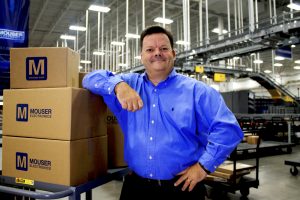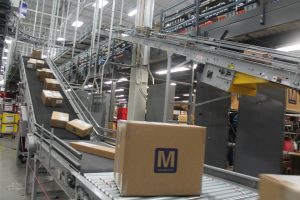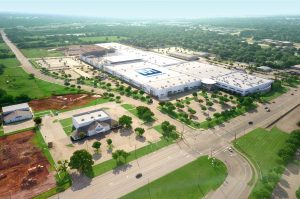
Challenges in the electronics supply chain
Stephen Law
Automation / Robotics Electronics Production / Materials Engineering Supply Chain distribution distribution supply Chain supply chainMouser Electronics details how it is tackling such issues as allocation, tariffs, compliance regulations and component obsolescence.
EP&T spoke with Mark Burr-Lonnon, senior vice president of global service & EMEA and APAC business at Mouser Electronics Inc., Mansfield TX.

Mark Burr-Lonnon, senior VP, stands near a stack of Mouser-branded boxes in the firm’s global distribution centre.
Q. Electronic component shortages are a classic case of demand outstripping supply. Today’s innovation boom is putting increased pressure on the need for electronic components. What are distributors, such as Mouser, doing to address allocation issues?
Regardless of whether allocation is at play, our Product Operations team constantly assesses our inventory position and the past, current and forecast environments to best support our customers. For example, building depth and breadth across our product lines is one way we work to meet customers’ needs in times of restricted supply. We stock the widest selection of components in the industry — currently more than one million different parts.
This strong inventory position insulates us greatly. Mouser’s corporate structure and distribution model uniquely position us to adapt quickly to global market fluctuations. While the industry saw shortages in IP&E products like MLCCs, we haven’t been affected as much as other distributors because of our vast inventory.
We continue to strengthen our line card by adding new manufacturers, giving our customers the widest assortment. Our focus on the newest products and technologies resonates with engineers worldwide. We are expanding our distribution facilities and capabilities at our corporate headquarters to meet future global demand. We opened a Canada branch office last year in the Waterloo/Kitchener area (Catalyst137), and are excited to be able to serve Canada with local support.
Q. All these developments are turning into procurement headaches as it becomes difficult for original equipment manufacturers to meet production schedules, limiting their growth. What can distributors do to prevent lead times from becoming extended and what are the challenges related to component obsolescence?
Ultimately suppliers are in control of their lead-times, but we can take actions to help protect our customers. Our teams continually evaluate our customers’ activity and plan our purchase orders accordingly to help build breadth and depth in line with demand.

Mouser ships orders same day with the assistance of state-of-the-art automation.
We also maintain open lines of communication with our suppliers regarding product on order or in transit. Providing our customers with information on product status and the availability of alternative options is imperative to providing best-in-class customer service.
We fully understand that engineers do not want to design with older components, so we flag these components on our website as NRND (Not Recommended for New Design) or EOL (End of Life), and notify customers when obsolescence is an issue. Plus we offer product alternatives, even providing the level of risk on the substitute part so customers can make an informed decision.
Q. The need for component information such as tariffs, country of origin and final assembly location has become vital. What can distributors do to ensure customers have the information needed to maintain compliance and reporting requirements?
We have invested heavily in our people and we employ knowledgeable and dedicated staff members equipped to handle quality and trade compliance questions. These teams continually refresh this kind of component data in our system because it is vital for Mouser to receive, stock and ship products effectively. We also have strong partnerships with our shipping carriers, including FedEx and UPS, working together to make the import/export process as streamlined as possible for customers.
As an authorized distributor for more than 750 manufacturers, our teams can provide timely and expert assistance to customers. We can answer their questions and make sure they have the necessary paperwork on traceability of products, customs paperwork, etc.
Q. During periods of component shortages, counterfeiters flood the market with fake, damaged or re-labelled parts. What can distributors do to ensure customers receive legitimate components?
This underscores the importance for customers to purchase only from authorized distributors. Mouser is registered to AS9100D/ISO9001:2015. Having aerospace registration demonstrates to our customers that Mouser is committed to only authorized genuine components with the least risk of counterfeit.

A massive expansion is underway at Mouser’s corporate headquarters and global distribution center in Mansfield, Texas.
Additionally, Mouser is the first distributor to be accredited and fully meet the coveted SAE AS6496 standard for anti-counterfeit measures in authorized electronic component distribution.
AS6496 sets requirements for the avoidance, detection, mitigation and disposition of counterfeit products in the authorized distribution supply chain. Overall, having this standard means we can provide full traceability to the original manufacturer on every product we stock and sell.
We have a zero tolerance policy and strict procedures in place, which mitigates the risk and helps to reassure our customers that they can order with confidence.
